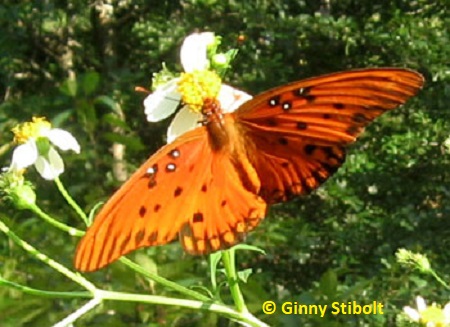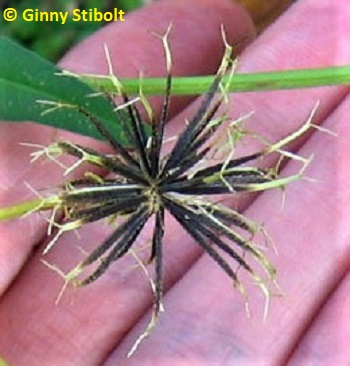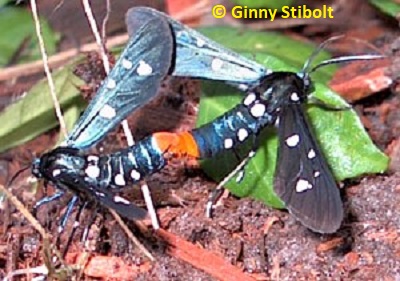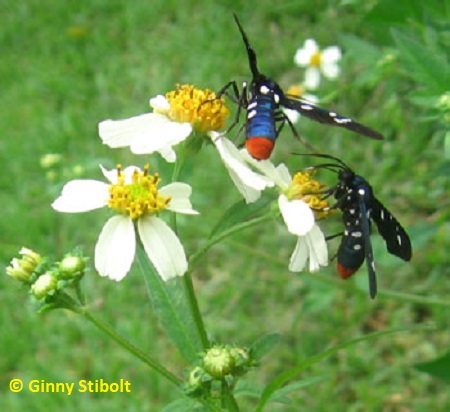Adventures of a Transplanted Gardener |
||||
No need to beg for beggarticks
| ||||
 |
Butterfly gardens
If you build a good butterfly garden, they will come. The first thing to do is to stop using all pesticides. Then you provide nectar sources (like beggarticks) for the adult butterflies, food for the larvae (caterpillars), shallow puddles or mud flats, and places for shelter. When you work to attract butterflies, you'll be supporting populations of other beneficial insects because most butterfly nectar sources also attract other pollinators. Additional insect habitat in your neighborhood's ecosystem also supports insect-eating birds, lizards, frogs, toads, and bats. In turn, they help to control garden pests. Your extension agent calls this integrated pest management, or IPM. It's a balance.
Since beggarticks are the nectar source of choice for many of our butterflies and moths, they can be an important addition to your butterfly garden. Gulf fritillary butterflies (as shown in this photo) snub my scarlet milkweed, which I bought, and visit the beggarticks instead. The monarchs still visit the milkweed, but I saw them on the beggarticks, too. In about 15 minutes on a recent sunny afternoon, I counted six different species of butterflies and several types of bees on the beggarticks. Since this plant is so weedy, it needs to be managed. I've cut it back with hedge clippers to keep it away from other plants and to maintain pathways in the meadows. It fills in nicely after it's been trimmed.
Beggarticks are important in other ways
 |
In addition to butterfly gardens, beggarticks have been important in at least two other ways: one was inspiration; the other for food.
In 1941 the idea for Velcro occurred to George de Mestral, a Swiss engineer, when he examined the beggarticks and burdock seeds that stuck in his dog's fur. He observed how well the little hooks on the seeds stuck to loops of fabric and fur and thought about the possibility of binding two materials reversibly in a similar fashion. He developed the hook and loop fastener and submitted his idea for patent in 1951. De Mestral named his invention "Velcro" after the French words velours, or 'velvet', and crochet, or 'hook'.
Plus the small seedlings are edible either raw in salads or cooked with other greens. So open your mind and see beggarticks in a new light. They are not just weeds anymore, but a valuable and ridiculously easy to grow butterfly magnet.
 |
* Polka-dot Wasp Moths (Syntomeida epilais)
With their iridescent gunmetal blue coloring punctuated by white dots and a bright red tip on their abdomens, these insects may look dangerous, but they're not. They are day-flying moths native to south Florida and the Caribbean Islands. The female polka-dot wasp moth emits ultra sonic sounds to attract a mate, not the scented pheromones like most other moths and butterflies. When the male comes within a few feet he'll start clicking as well.
These days, the larvae feed mostly on the poisonous oleander shrubs (Nerium oleander), so they are also called the oleander moth. Because of the toxic larval food and their warning coloration, most predators will not eat them. Before the Spanish missionaries imported the oleanders, researchers think that the devil's potato (Echites umbellata) used to be the main host plant for the caterpillar. Both plants are in the dogbane family or Apocynaceae. Sometimes the larvae are found on other members of the dogbane family, but they mostly use oleander as their host plant and have increased their range with the plantings of this Mediterranean shrub. Groups of these ravenous caterpillars can strip bare an entire shrub in a matter of a day or two. Except for California, the polka-dot wasp moth is now found wherever there are oleanders in the Americas. We don't have any oleanders in our yard, but looking at the large population of wasp moths this year, our neighbors' oleanders must have taken a beating earlier in the season.
Resources:
· The Florida Native Plant Society's website lists
native plants by county and whether they are butterfly garden plants--either
nectar or larval. www.fnps.org
· Learn more about Integrated Pest Management at University
of Florida's IPM website: http://ipm.ifas.ufl.edu/
· My articles on backyard habitat
and meadow management have additional
information on creating butterfly-friendly spaces.
Ginny Stibolt is a life-long gardener, a botanist, a naturalist, and a garden writer. You may contact her or read more of her articles posted on her website: www.greengardeningmatters.com.
Copyright Ginny Stibolt


